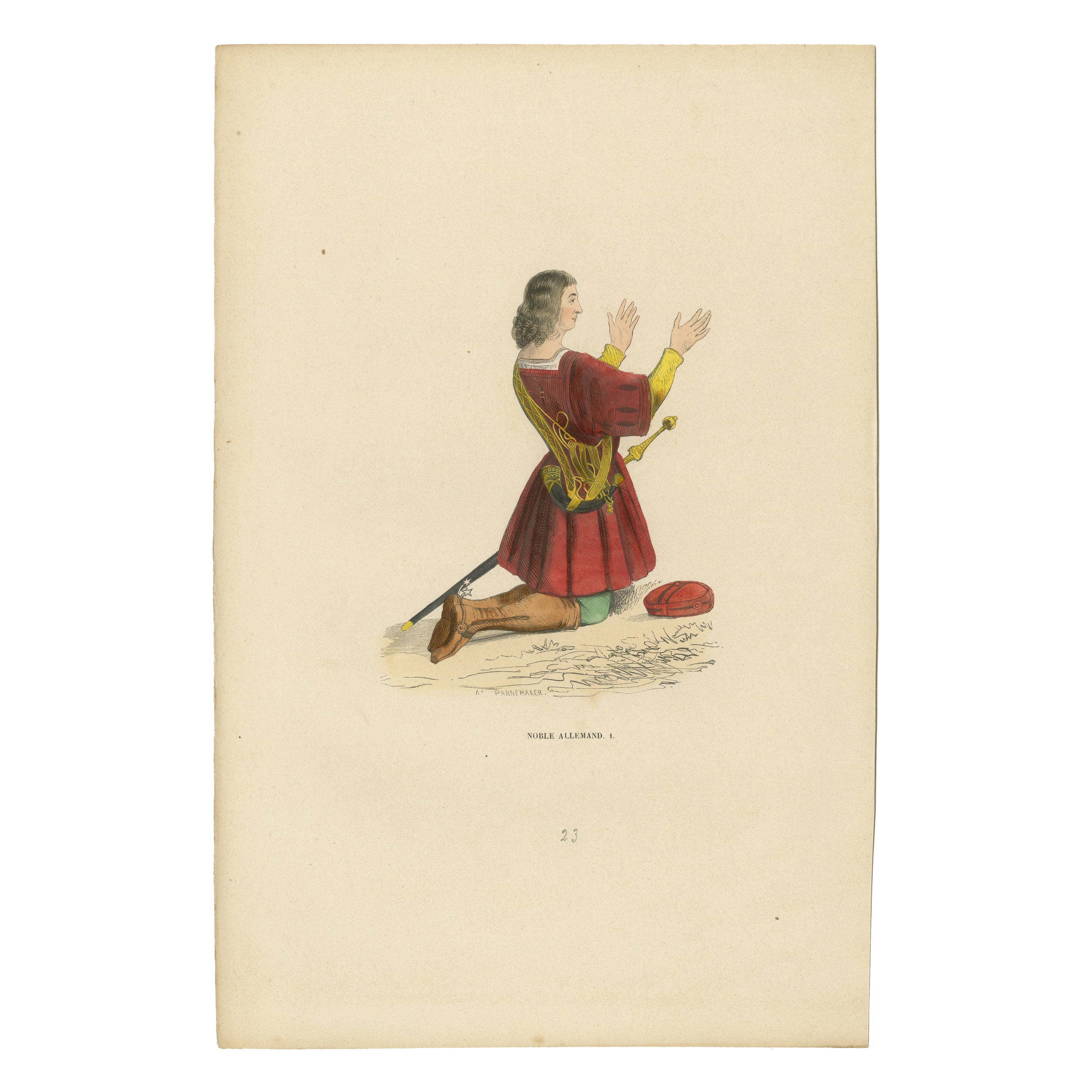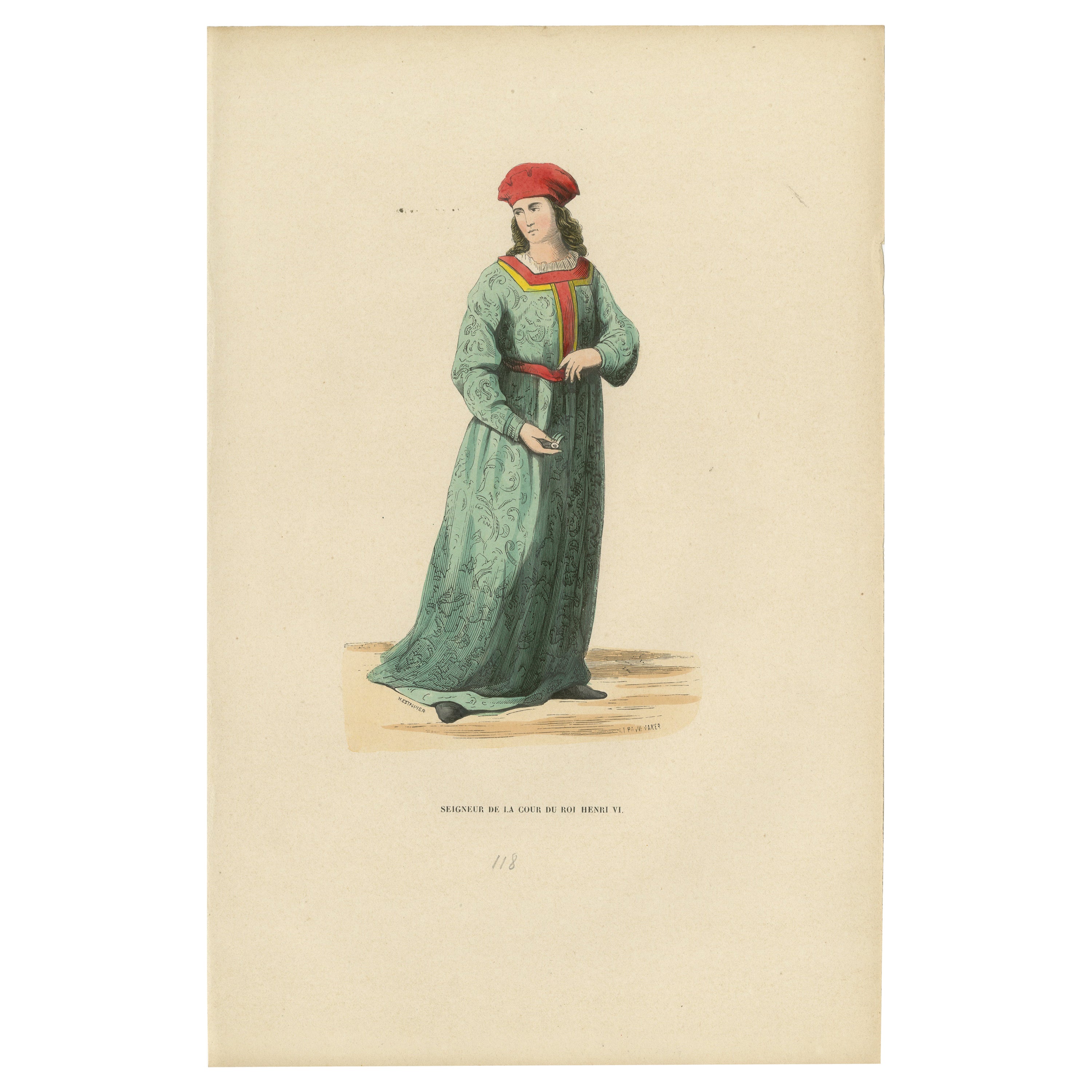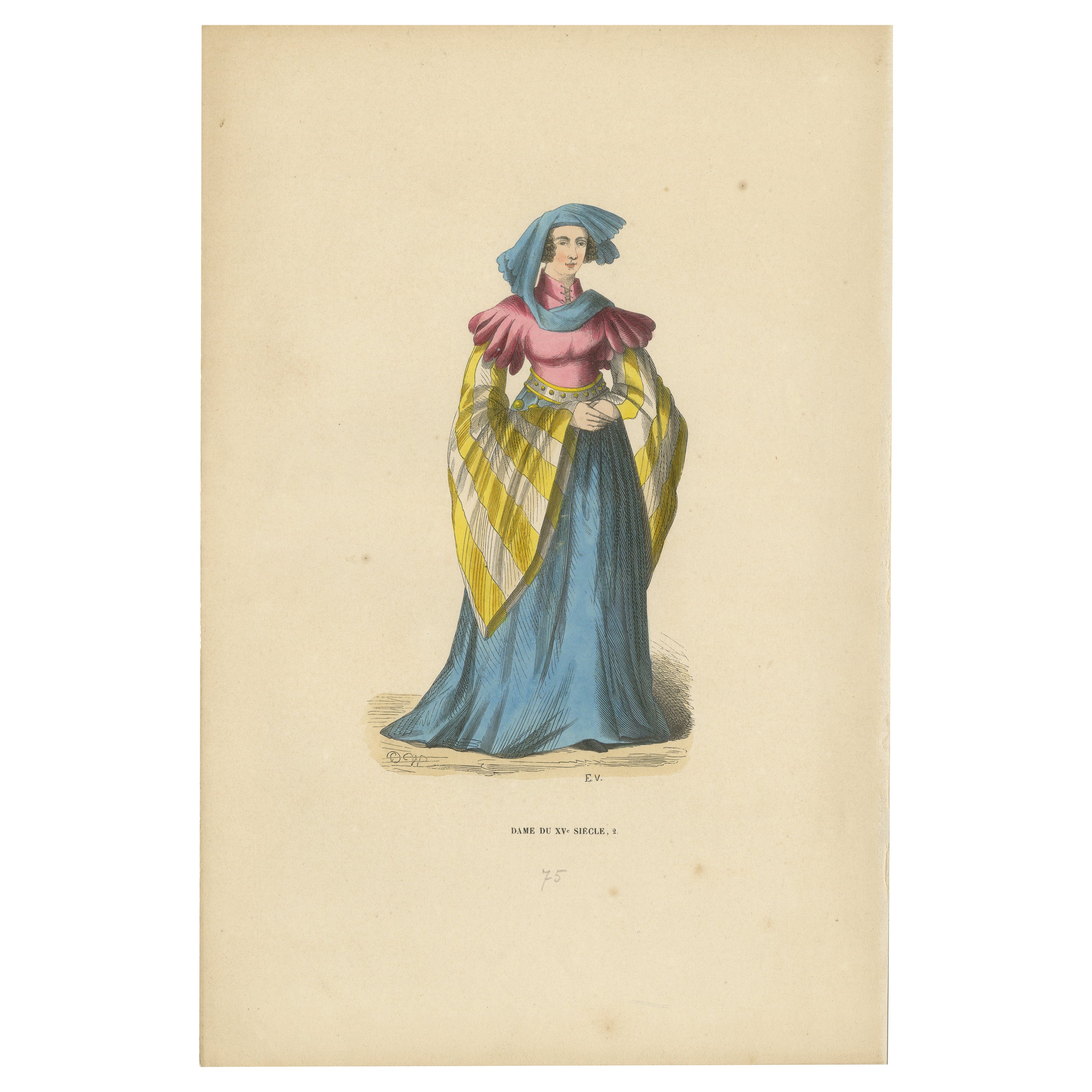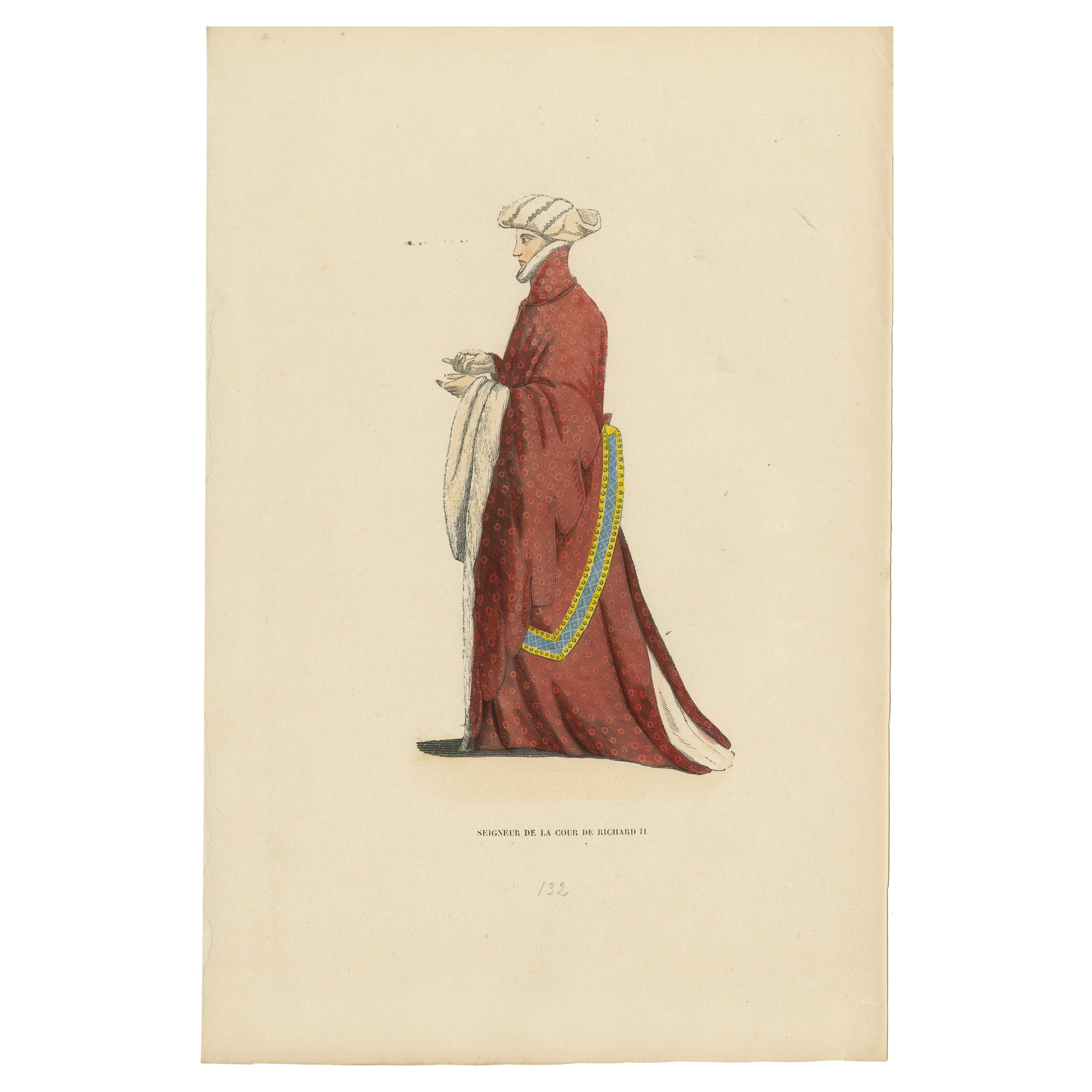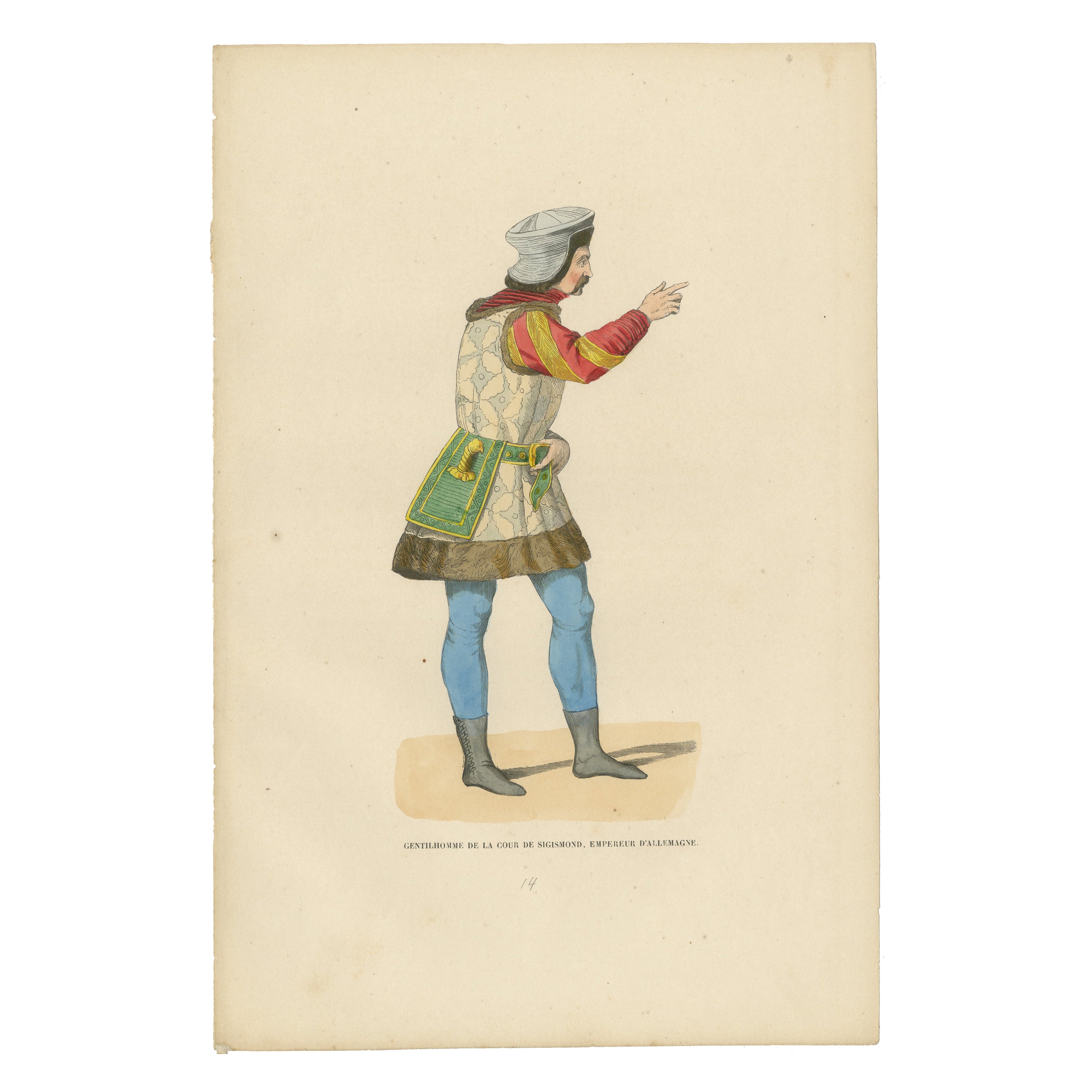Items Similar to Elegance at the Court of Louis XII: A French Noble's Poise, 1847
Want more images or videos?
Request additional images or videos from the seller
1 of 6
Elegance at the Court of Louis XII: A French Noble's Poise, 1847
About the Item
Title: "Elegance at the Court of Louis XII: A French Noble's Poise"
Description: This delicate historical illustration depicts a French nobleman from the court of King Louis XII, elegantly attired in the fashion of the early 16th century. He stands with a composed and dignified stance, a walking stick in one hand, exuding the grace and refinement expected of someone from his esteemed position.
His attire is a rich blend of colors and textures, indicative of his status. The nobleman wears a soft pink tunic, a color that during the time was often associated with nobility due to the expense of the dye required to produce it. The tunic is complemented by a deep green overcoat with a luxurious fur trim that adds both warmth and a touch of opulence to his ensemble.
The hat, an important status symbol of the time, is fashioned in a black fabric that contrasts with his lighter clothing, completing his attire with a note of seriousness. This hat, along with the belt adorned with a decorative purse, signals his wealth and rank.
The image captures the essence of court life during the reign of Louis XII, a period noted for its artistic and cultural achievements. It is a snapshot of history, reflecting the intricate sartorial customs that were an integral part of the noble identity in the French court. The nobleman's attire is not just clothing but a narrative of status, culture, and the aesthetics of an era where appearance was a key indicator of one's place in the social hierarchy.
The colors have a nice glow over them. Historically, egg whites, known as glair, and sometimes egg yolk were indeed used in illumination and painting, particularly in manuscripts, to give colors a brighter appearance and to add a sheen or gloss to the work. This technique was quite common during the Middle Ages and into the Renaissance.
Egg whites can be applied as a varnish over pigments to enhance their brightness and to protect the colors. This application could make the colors appear more vivid and also add a slight glossy sheen to the surface of the image.
Egg yolk, on the other hand, was commonly used as a binding agent in paint. It forms the basis of tempera paint, a medium that was widely used before the advent of oil painting. Egg yolk helps to create a durable and long-lasting color that adheres well to various surfaces.
In the context of the print from 1847, it's less likely that egg whites or yolks were used directly on the print, as by that time, commercial printing processes would have been more advanced and less reliant on such manual methods. However, if this print is a representation of an earlier style or is meant to mimic the appearance of hand-painted manuscripts, the original artists might have employed techniques or materials that gave a similar effect to those achieved with egg-based binders and varnishes.
- Dimensions:Height: 10.63 in (27 cm)Width: 7.09 in (18 cm)Depth: 0 in (0.02 mm)
- Materials and Techniques:
- Period:
- Date of Manufacture:1847
- Condition:Good. Overal light toning and light soiling but the image itself clean and hand-colored almost 200 years ago and still in expliciet colors. Aged paper with typically warm, yellowish-brown hue, mostly around the edges. Study the images carefully.
- Seller Location:Langweer, NL
- Reference Number:
About the Seller
5.0
Platinum Seller
These expertly vetted sellers are 1stDibs' most experienced sellers and are rated highest by our customers.
Established in 2009
1stDibs seller since 2017
1,919 sales on 1stDibs
Typical response time: <1 hour
- ShippingRetrieving quote...Ships From: Langweer, Netherlands
- Return PolicyA return for this item may be initiated within 14 days of delivery.
More From This SellerView All
- The Noble's Plea: A German Aristocrat in Supplication, 1847Located in Langweer, NLThe image depicts a figure labeled as "Noble Allemand," which means "German Noble." The nobleman is shown kneeling on one leg, with his hands raised in what could be a gesture of exc...Category
Antique 1840s Prints
MaterialsPaper
- Aristocratic Elegance in the Court of King Henry VI: A Noble Lord Dressep UpLocated in Langweer, NLTitle: "Seigneur de la Cour du Roi Henri VI" (Lord of the Court of King Henry VI) Description: This hand-colored engraving from the 1847 "Costume du Moyen Age" series represents a nobleman from the court of King Henry VI. The title "Seigneur de la Cour du Roi Henri VI" identifies the subject as a lord or high-ranking individual within the royal court of the 15th-century English monarch. The lord is portrayed in a long, ornately patterned robe that falls gracefully to the ground, indicative of the elaborate fashion of the high nobility during the time. The garment is colored in a rich teal hue, with a detailed pattern that suggests luxury and status. The robe is trimmed with a contrasting color at the neck and cuffs, and a red belt cinches the robe at the waist, highlighting the layered aspect of medieval...Category
Antique 1840s Prints
MaterialsPaper
- 15th Century Elegance: Lady of the Court, Engraved and Published in 1847Located in Langweer, NLTitle: "15th Century Elegance: Lady of the Court" Description: This print presents a lady of the 15th century, elegantly attired in the fashion of the European high nobility. Her dr...Category
Antique 1840s Prints
MaterialsPaper
- Louis XII: The Prudent King in Regal Attire, 1847Located in Langweer, NLThis print presents a dignified portrait of Louis XII, King of France, known for his prudent and just reign. Standing in profile, the king is depicted in royal attire that is both la...Category
Antique 1840s Prints
MaterialsPaper
- Aristocratic Elegance: A Lord of Richard II's Court, Original Old Print of 1847Located in Langweer, NLTitle: "Aristocratic Elegance: A Lord of Richard II's Court in 'Costume du Moyen Âge'" Description: This lithograph from "Costume du Moyen Âge," dated 1847, presents a nobleman from...Category
Antique 1840s Prints
MaterialsPaper
- Courtly Splendor: A Nobleman at Emperor Sigismund's Court, 1847Located in Langweer, NLThe image depicts a man identified as a "Gentilhomme de la cour de Sigismond, empereur d'Allemagne," which translates to "Gentleman of the court of Sigismund, Emperor of Germany." This individual is portrayed in a profile stance, dressed in attire that is indicative of the high-status courtiers during the time of Emperor Sigismund, who reigned in the early 15th century. He is wearing a turban-like headgear, which reflects the influence of Eastern fashion on European court attire, possibly due to the Ottoman influence or the general exchange of culture during the Crusades and subsequent interactions. His doublet is richly patterned and he has puffed sleeves in red, which were fashionable among the nobility during the period. The garment is accented with a decorative belt that holds what appears to be a purse or a pouch. He also sports tight blue hose and pointed shoes, which complete the ensemble typical of a nobleman or a high-ranking court official in the Holy Roman Empire. Egg whites can be applied as a varnish over pigments to enhance their brightness and to protect the colors. This application could make the colors appear more vivid and also add a slight glossy sheen to the surface of the image. Egg yolk, on the other hand, was commonly used as a binding agent in paint. It forms the basis of tempera paint, a medium that was widely used before the advent of oil painting. Egg yolk helps to create a durable and long-lasting color that adheres well to various surfaces. In the context of the print from 1847, it's less likely that egg whites or yolks were used directly on the print, as by that time, commercial printing processes would have been more advanced and less reliant on such manual methods. However, if this print is a representation of an earlier style or is meant to mimic the appearance of hand-painted manuscripts...Category
Antique 1840s Prints
MaterialsPaper
You May Also Like
- A Set of Six French Prints of French and Italian Noble CostumesLocated in Roma, ITA beautiful set of Six prints each dipicting French and Italian noblemen in their formal 18th and 19h century costumes. The prints are in good condition considering their age but al...Category
20th Century French Prints
MaterialsPaint, Paper
- Hush, Poise, Limited Edition Screen PrintBy HUSHLocated in Miami, FL18 layer limited edition screen print on 300gsm somerset white satin hand pressed cotton paper with a gloss UV finish over figure, editio...Category
21st Century and Contemporary English Other Contemporary Art
MaterialsPaper
- Pair Prints of French Noble Couples of 16th Century Made Mid-19th Century FranceLocated in Katonah, NYA pair of outstanding prints of French nobles of the 16th century. The costumes are exquisite! The captions under each figure indicate that the figures and their costumes were from the period of Henri III...Category
Antique Mid-19th Century French Louis Philippe Prints
MaterialsPaper
- Louis Icart, Etching on Paper, "at the Urn", Dated 1923Located in Copenhagen, DKLouis Icart (1888-1950). Etching on paper. "At the Urn". Dated 1923. Visible dimensions: 44 x 33 cm. Total dimensions: 48 x 38 cm. The frame measures: 1.5 cm. In excellent condit...Category
Vintage 1920s French Art Deco Prints
MaterialsPaper
- 19C Aquatint Engraving of the Quay at WaterfordLocated in Dallas, TXPresenting a lovely 19C Aquatint Engraving of the Quay at Waterford in Waterford city in Ireland. This engraving has been hand embellished with aquatint color(s) and is from Ireland circa 1820-40. It features a scene of the Quay or Port of Waterford from circa 1820. We are basing this upon the attire of the figures in the engraving and the tall ships. It features Reginald’s Tower (still located at the Waterford Quay to this day). Georgian Quay buildings, a number of moored tall ships and row boats, barrels, horses and carts, women and British soldiers. The engraving was professionally reframed and matted in Dallas in the 1980’s and the rear of the frame says that it was “Museum Mounted and Matted”. The frame has a lovely Grecian pattern around the front. If you are Irish...Category
Antique Mid-19th Century Irish George III Prints
MaterialsPaper
- Original Antique Print of a Hummingbird, 1847 'Unframed'Located in St Annes, LancashireGreat image of a hummingbird. Unframed. It gives you the option of perhaps making a set up using your own choice of frames. Lithograph after Captain Brown with original hand color....Category
Antique 1840s English Folk Art Prints
MaterialsPaper
